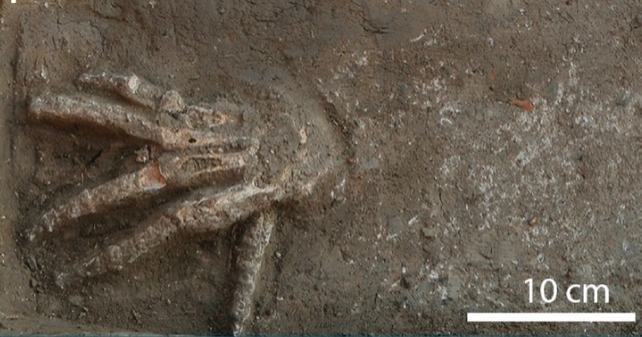Archaeologists have made a grisly discovery at an ancient Egyptian palace site in northeastern Egypt. The team, led by Julia Gresky of the German Archaeological Institute in Berlin, has found physical evidence of an ancient practice that was previously only known from iconographic and literary sources.

Right Hands in the Pits
They have found 12 to 18 right hands buried beneath pits in the forecourt of Hyksos palace at Avaris, offering new insights into the practices of ancient Egypt.
The researchers believe that the hands were not all fully intact and were interred together, making it difficult to determine the minimum and maximum number of individuals required to make up the remains.
However, the researchers managed to determine that the minimum number of hands found was 12, with 18 being the uppermost range.
The hands were discovered in three different pits in the area that would have been the palace's entrance court in front of the throne room. The scholars claim that the severed hands positioned there were meant to be observed and would have been a striking sight.
The hands were likely to be a part of a ceremony at the palace, and the sight of so many severed hands would have given onlookers a new viewpoint.
The researchers were able to establish that the hands' minimum ages were set between 14 and 21 years, with the top age range being below 60, even though hands can be tough to examine forensically.
Eleven of the hands were identified as male, with the 12th being undetermined, based on the sturdy structure of the bones and a morphological tendency for their index fingers to be longer than their ring fingers.
Shrouded in Mystery
The exact moment of the incident and whether the hands were from live or dead people are still shrouded in mystery. The researchers contend that the hands had to have been soft and flexible to fit inside the pit.
The most likely scenario is that the hands found their way to the pits 24 to 48 hours after collecting. This implies it took at least a day between the amputation and placement in the palace.
Another intriguing aspect is the absence of any traces of the forearms to which the hands were formerly linked. This shows that extra care was taken to ensure that only the anatomical hands were on exhibit by eliminating all traces of the appendage.
However, according to the team, it is impossible to tell if the hands were removed neatly from the arms or if the removal process left some mess.
Although there is not much proof of hand severing before the era of the pits, iconographic reports from 50 to 80 years later mention the practice.
If this is the case, the authors speculate that the communities where the Hyksos leadership first emerged may have been where the activity in Egypt began.
Iconographic documents show that in the succeeding dynasties, taking a hand from an enemy developed into a custom in battle. This discovery is the first reported physical evidence of the practice.
The researchers' findings have been published in the journal Scientific Reports.
Related Article : Archaeologists May Have Discovered Egypt's Oldest, Most Complete Mummy at 4,300 Years

![Apple Watch Series 10 [GPS 42mm]](https://d.techtimes.com/en/full/453899/apple-watch-series-10-gps-42mm.jpg?w=184&h=103&f=9fb3c2ea2db928c663d1d2eadbcb3e52)



